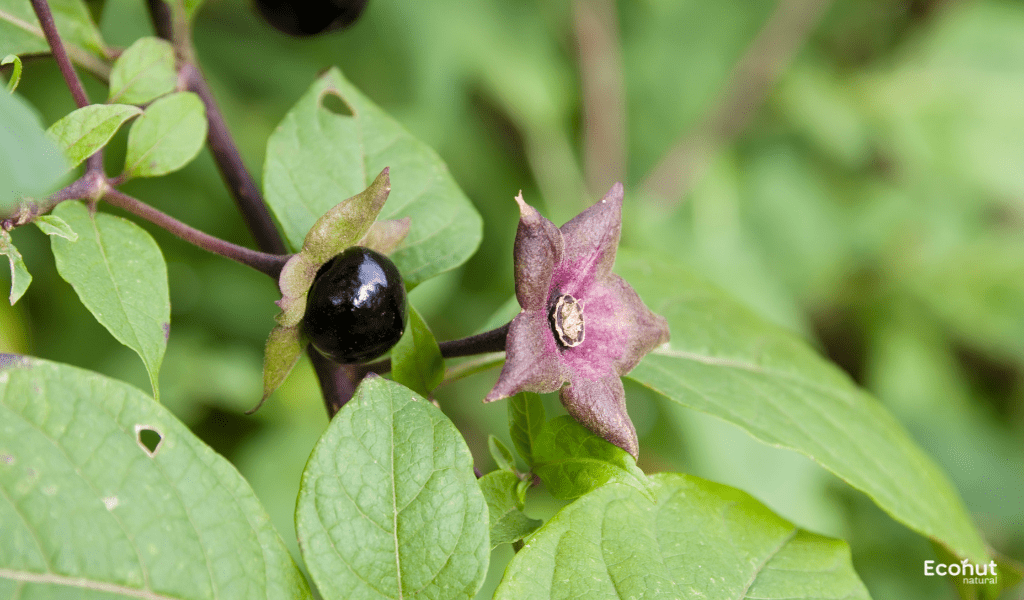The origin of Angurshafa (Atropa belladonna is in Eurasia. This is a type of small plant that bears jet black fruits and has lovely bell-shaped, red blossoms. The main chemical components of this shrub are tropane alkaloids, which include atropine, hyoscyamine, and hyoscine (scopolamine). These constituents give this herb its reputation as being more potent.
Belladonna yields tiny black berries that are toxic to consume. It can be fatal to eat the leaves or berries. A rash can appear on someone whose skin comes into direct touch with the leaves, just like with poison ivy.
Description
The perennial herbaceous plant Atropa belladonna belongs to the Solanaceae family of nightshades and is primarily found in western Asia, North Africa, and Europe. When this substance is used excessively, it might cause some very harmful adverse effects, including as tract infections, irritability, and constipation. Since belladonna is mostly used as a sedative, doctors advise patients with asthma as well as those who have whooping cough, colds, or hay fever to take this plant.
Botanical Name:
Atropa belladonna
Family:
Solanaceae
Leaves:
Large, oval-shaped, and entire arranged alternately on the stem. They have a pointed tip and a slightly glossy surface. The leaves are dark green on top and lighter green underneath, with prominent veins.
Flowers:
Bell-shaped, drooping, and solitary, arising from the forks of the stems they are typically a dull purple or brownish-purple color with five lobes.
Berries:
Black, round, and shiny, roughly the size of a cherry they have a luscious, meaty interior and are borne singly on the stem. Berries are green when unripe and turn black when ripe.
Stems:
Erect, hairless, branching and reaching a height of five feet, or up to 1.5 meters
Habitat:
Although it is native to calcareous soils in Britain and throughout Europe, human planting has led to a far wider distribution. The understory of forests and marginal habitats like hedgerows and areas next to walls are the native habitats of deadly nightshade.
Parts Used:
- Roots
Dosage
- Powder- 30 to 60 mg
Chemical Constituents
The main chemical components of this shrub are tropane alkaloids, atropine, hyoscyamine, and hyoscine (scopolamine).
Other Language Names of Angurshafa (Atropa belladonna)
Hindi name – Saag angur, angur shafa
Bengali name – Yebrooj
Bombay name – Girbuti
Kannada name – Jhallakphala
Punjabi name – Soochi
Scientific Classification
| Kingdom | Plantae |
| Subkingdom | Tracheophyta |
| Superdivision | Spermatophyta |
| Division | Magnoliophyta |
| Class | Magnoliopsida |
| Order | Solanales |
| Family | Solanaceae |
Ayurvedic Properties
Rasa (Taste) – Tikta (Bitter), Katu (Pungent)
Guna (Quality) – Laghu (Light), Ruksha (Dry)
Veerya (Potency) – Ushna (hot)
Vipaka (Post digestive effect) – Katu (Pungent)
Karma (Action) – Balances the Kapha and vata dosha and enhances the Pitta dosha.
Angurshafa (Atropa belladonna) Uses
- This herb is useful in treating peptic ulcers and GERD because it has the ability to bind acetylcholine to muscarinic receptors, which inhibits smooth muscle activity and effectively prevents the production of gastric and pancreatic juices.
- This plant helps lessen excessive sweating on the body’s taut areas.
- This is given topically to the inflammatory areas. We can also utilize this shrub in its oil or paste form for arthritic individuals with cervical spondylosis, where the inflammation is in the joints.
- Its leaves are also used to treat diabetes and other conditions involving the urinary tract.
Angurshafa (Atropa belladonna) Benefits
Muscle relaxation:
Belladonna has a calming effect on muscles, particularly those of the urinary and digestive systems. Urinary incontinence, ulcers, and IBS can all benefit from this.
Headache:
Angurshafa (Atropa belladonna), in small doses, has been found in a few studies to be helpful in treating headaches. It works well for migraines, sinus congestion, and drowsiness-related headaches. It eases headaches and relaxes tense muscles.
Lung Congestion:
Alkaloids included in Atropa belladonna lessen the development of excess mucus. Furthermore, it lessens inflammation and prevents the production of inflammatory mediators, which irritate the respiratory system in other cases.
Persistent Hiccup:
Persistent hiccups are most frequently caused by ongoing irritation of the vagus nerve. But some food cues can also irritate the diaphragm, causing it to constrict involuntarily. Atropa belladonna eases nerve discomfort and relaxes the diaphragm. It therefore starts to work in cases with chronic hiccup.
Angurshafa (Atropa belladonna) Side Effects
Difficulty urinating:
If you ignore this, it can become unpleasant and result in UTIs.
Blurred vision:
This can be risky, particularly if you’re driving or operating machinery.
Rapid heartbeat:
This may put stress on the heart and result in more issues.
Increased body temperature:
This necessitates medical treatment as it may indicate a dangerous reaction.
Pregnancy & breastfeeding:
When taking Atropa belladonna while pregnant or nursing, it may be TOXIC and UNSAFE. It may result in less breast milk when nursing a baby and have major adverse effects during pregnancy.
Read Also: Ketak, Scre pin (Pandanus odorotissimus) – Classification, Properties, Uses, Benefits &Side Effects
Conclusion
Since belladonna is mostly used as a sedative, doctors advise patients with asthma as well as those who have whooping cough, colds, or hay fever to take this plant. It is also helpful for its analgesic qualities and is utilized in various Vataj illnesses, such as Parkinsonism and Irritable bowel syndrome.
FAQS
What are the benefits of Angurshafa (Atropa belladonna)?
Belladonna is taken orally as a sedative, to relieve bronchial spasms in asthma and whooping cough, and as a treatment for colds and hay fever, despite the fact that it is generally considered being hazardous. In addition, it is used as a pain reliever, for motion sickness, colic, Parkinson’s disease, and inflammatory bowel disease.
What was Atropa belladonna used for?
In order to dilate their patients’ pupils for eye exams and surgery, ophthalmologists employ atropine. Moreover, atropine is utilized to treat opium and chloroform toxicity. Belladonna preparations in various forms are used as salves, plasters, and lotions to treat cardiac palpitations, gout, and sciatica pain.
What is the side effect of belladonna?
If consumed orally: Belladonna probably poses a risk. Even at modest concentrations, the compounds it contains have the potential to be toxic. Some serious side effects that may occur are impaired vision, fever, rapid heartbeat, sweating or inability to urinate, convulsions, mental disorders, hallucinations, and coma.

